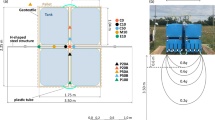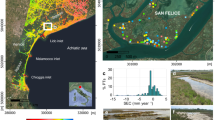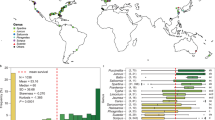Abstract
Salt marshes are hotspots of nutrient processing and carbon sequestration. So far, studies addressing spatiotemporal variability in and drivers of salt marsh biogeochemical function, carbon storage and resilience have focused on ocean-driven surface hydrologic influences, neglecting effects of terrestrial hydrology through subsurface connections. Here we evaluate drivers of salt marsh redox potential, a proxy for biogeochemical state, through wavelet analyses and information theory using data from seven marshes. The results point to terrestrial groundwater level as a dominant control on redox variability across all sites. Because redox is a key driver of biogeochemical processes, and specifically oxidation of organic matter that sequesters carbon and maintains marsh elevation, these terrestrial influences are critical to understanding marsh function and evolution. The newly identified links between onshore groundwater levels and marsh redox conditions shift the traditional paradigm and suggest that terrestrial hydrology is a primary control on salt marsh carbon sequestration potential and resilience.
This is a preview of subscription content, access via your institution
Access options
Subscribe to this journal
Receive 12 digital issues and online access to articles
118,99 € per year
only 9,92 € per issue
Buy this article
- Purchase on SpringerLink
- Instant access to full article PDF
Prices may be subject to local taxes which are calculated during checkout




Similar content being viewed by others
Data availability
All data are available in public repositories or included as supplementary data as indicated in the text.
Code availability
The codes to replicate the analysis are available via Zenodo at https://doi.org/10.5281/zenodo.10855140 (ref. 62).
References
Santos, I. R. et al. The renaissance of Odum’s outwelling hypothesis in ‘blue carbon’ science. Estuar. Coast. Shelf Sci. 255, 107361 (2021).
Bowen, J. L., Spivak, A. C., Bernhard, A. E., Fulweiler, R. W. & Giblin, A. E. Salt marsh nitrogen cycling: where land meets sea. Trends Microbiol. 32, 565–576 (2024).
Guimond, J. & Tamborski, J. Salt marsh hydrogeology: a review. Water 13, 543 (2021).
Kirwan, M. L. & Gedan, K. B. Sea-level driven land conversion and the formation of ghost forests. Nat. Clim. Change 9, 450–457 (2019).
Kirwan, M. & Temmerman, S. Coastal marsh response to historical and future sea-level acceleration. Quat. Sci. Rev. 28, 1801–1808 (2009).
Nuttle, W. K. & Harvey, J. W. Fluxes of water and solute in a coastal wetland sediment. l. The contribution of regional groundwater discharge. J. Hydrol. 164, 89–107 (1995).
Yabusaki, S. B. et al. Floodplain inundation and salinization from a recently restored first‐order tidal stream. Water Resour. Res. 56, e2019WR026850 (2020).
Jasechko, S., Perrone, D., Seybold, H., Fan, Y. & Kirchner, J. W. Groundwater level observations in 250,000 coastal US wells reveal scope of potential seawater intrusion. Nat. Commun. 11, 3229 (2020).
Burgin, A. J. & Loecke, T. D. The biogeochemical redox paradox: how can we make a foundational concept more predictive of biogeochemical state changes? Biogeochemistry 164, 349–370 (2023).
Zhang, Z. & Furman, A. Soil redox dynamics under dynamic hydrologic regimes—a review. Sci. Total Environ. 763, 143026 (2021).
Bianchi, T. S. et al. Redox effects on organic matter storage in coastal sediments during the holocene: a biomarker/proxy perspective. Annu. Rev. Earth Planet. Sci. 44, 295–319 (2016).
Eduru, H. V., Vivek, Y., Ravi, V. & Shankar, O. S. Parallel and streaming wavelet neural networks for classification and regression under Apache Spark. Cluster Comput. 27, 3451–3469 (2024).
Roman, C., Niering, W. & Warren, R. Salt marsh vegetation change in response to tidal restriction. Environ. Manag. 8, 141–149 (1984).
Grande, E. et al. Tidal frequencies and quasiperiodic subsurface water level variations dominate redox dynamics in a salt marsh system. Hydrol. Process. 36, e14587 (2022).
Guimond, J. A., Seyfferth, A. L., Moffett, K. B. & Michael, H. A. A physical-biogeochemical mechanism for negative feedback between marsh crabs and carbon storage. Environ. Res. Lett. 15, 34024 (2020).
Wilson, A. M. & Gardner, L. R. Tidally driven groundwater flow and solute exchange in a marsh: numerical simulations. Water Resour. Res. 42, 2005WR004302 (2006).
Grande, E. et al. Seasonal and tidal variations in hydrologic inputs drive salt marsh porewater nitrate dynamics. Hydrol. Process. 37, e14951 (2023).
Seyfferth, A. L. et al. Spatial and temporal heterogeneity of geochemical controls on carbon cycling in a tidal salt marsh. Geochim. Cosmochim. Acta 282, 1–18 (2020).
Regier, P. et al. Biogeochemical control points of connectivity between a tidal creek and its floodplain. Limnol. Oceanogr. Lett. 6, 134–142 (2021).
Harvey, J. W. & Odum, W. E. The influence of tidal marshes on upland groundwater discharge to estuaries. Biogeochemistry 10, 217–236 (1990).
Braswell, A. E., Heffernan, J. B. & Kirwan, M. L. How old are marshes on the East Coast, USA? Complex patterns in wetland age within and among regions. Geophys. Res. Lett. 47, e2020GL089415 (2020).
Scott, D. B., Frail-Gauthier, J., Mudie, P. J. & Mudie, P. J. Coastal Wetlands of the World: Geology, Ecology, Distribution and Applications (Cambridge Univ. Press, 2014).
Montalvo, M. S. et al. A fresh take: seasonal changes in terrestrial freshwater inputs impact salt marsh hydrology and vegetation dynamics. Estuar. Coasts 47, 2389–2405 (2024).
Wilson, A. M. et al. Groundwater controls ecological zonation of salt marsh macrophytes. Ecology 96, 840–849 (2015).
Roulet, N. T. Hydrology of a headwater basin wetland: groundwater discharge and wetland maintenance. Hydrol. Process. 4, 387–400 (1990).
Armandine Les Landes, A. et al. Investigating the respective impacts of groundwater exploitation and climate change on wetland extension over 150 years. J. Hydrol. 509, 367–378 (2014).
Boomer, K. M. B. & Bedford, B. L. Influence of nested groundwater systems on reduction–oxidation and alkalinity gradients with implications for plant nutrient availability in four New York fens. J. Hydrol. 351, 107–125 (2008).
Wada, Y. et al. Global depletion of groundwater resources. Geophys. Res. Lett. 37, L20402 (2010).
Michael, H. A., Post, V. E. A., Wilson, A. M. & Werner, A. D. Science, society, and the coastal groundwater squeeze. Water Resour. Res. 53, 2610–2617 (2017).
Grande, E. et al. Flow directions and ages of subsurface water in a salt marsh system constrained by isotope tracing. Estuar. Coasts 46, 1417–1437 (2023).
Moffett, K. B., Wolf, A., Berry, J. A. & Gorelick, S. M. Salt marsh–atmosphere exchange of energy, water vapor, and carbon dioxide: effects of tidal flooding and biophysical controls. Water Resour. Res. 46, 2009WR009041 (2010).
Jasechko, S. et al. Rapid groundwater decline and some cases of recovery in aquifers globally. Nature 625, 715–721 (2024).
Richardson, C. M. et al. The impacts of climate change on coastal groundwater. Nat. Rev. Earth Environ. 5, 100–119 (2024).
Ward, N. D. et al. Representing the function and sensitivity of coastal interfaces in Earth system models. Nat. Commun. 11, 2458 (2020).
Delaware National Estuarine Research Reserve: Estuarine Profile (Delaware Department of Natural Resources and Environmental Control, 1999).
NOAA National Estuarine Research Reserve System (NERRS) System‐Wide Monitoring Program INOAA NERRS Centralized Data Management Office, 2021); http://www.nerrsdata.org/
Schwartz, D. L., Mullins, H. T. & Belknap, D. F. Holocene geologic history of a transform margin estuary: Elkhorn Slough, central California. Estuar. Coast. Shelf Sci. 22, 285–302 (1986).
Grande, E., Arora, B. & Zimmer, M. Subsurface redox potential and water level at the Elkhorn Slough NERR. US Department of Energy https://www.osti.gov/dataexplorer/biblio/dataset/1846282 (2022).
Grande, E., Zimmer, M., Seybold, E. & Tatariw, C. Modeled sub-hourly nitrate concentrations in subsurface water across a salt marsh system in Elkhorn Slough, California. ESS-DIVE https://data.ess-dive.lbl.gov/datasets/doi:10.15485/1987518 (2023).
Grande, E., Visser, A. & Zimmer, M. Stable water isotopes and tritium data from porewater at Elkhorn Slough. ESS-DIVE https://data.ess-dive.lbl.gov/datasets/doi:10.15485/1970526 (2023).
Arora, B. et al. in Biogeochemistry of the Critical Zone (eds Wymore, A. S. et al.) 9–47 (Springer, 2022); https://doi.org/10.1007/978-3-030-95921-0_2
Arora, B., Dwivedi, D., Hubbard, S. S., Steefel, C. I. & Williams, K. H. Identifying geochemical hot moments and their controls on a contaminated river floodplain system using wavelet and entropy approaches. Environ. Model. Softw. 85, 27–41 (2016).
Daubechies, I. Ten Lectures on Wavelets (Society for Industrial and Applied Mathematics, 1992); https://doi.org/10.1137/1.9781611970104
Grinsted, A., Moore, J. C. & Jevrejeva, S. Application of the cross wavelet transform and wavelet coherence to geophysical time series. Nonlinear Process. Geophys. 11, 561–566 (2004).
Percival, D. B. & Walden, A. T. Wavelet Methods for Time Series Analysis (Cambridge Univ. Press, 2006).
Mallat, S. A Wavelet Tour of Signal Processing: The Sparse Way (Wavelet Analysis & Its Applications) (Academic Press, 1999).
Zhang, X. et al. Inferring gene regulatory networks from gene expression data by path consistency algorithm based on conditional mutual information. Bioinformatics 28, 98–104 (2012).
Shannon, C. E. & Weaver, W. The Mathematical Theory of Communication (Univ. Illinois Press, 1998).
Guimond, J. A. St. Jones data compilation 2017. HydroShare https://doi.org/10.4211/hs.8f0b5599b871457ebb47f0bac898f156 (2019).
Guimond, J. A. St. Jones monitoring well data 2017–2018. HydroShare https://doi.org/10.4211/hs.e9de2725c1d442e1bd2ab8e0c4d45efc (2020).
Guimond, J. A., Yu, X., Seyfferth, A. L. & Michael, H. A. Using hydrological–biogeochemical linkages to elucidate carbon dynamics in coastal marshes subject to relative sea level rise. Water Resour. Res. 56, e2019WR026302 (2020).
Simcox, A. C. Water Resources of Massachusetts Water-Resources Investigations Report (USGS, 1992); https://pubs.usgs.gov/publication/wri904144
Pratt, D., Michael, H., Sprague-Getsy, A., Guimond, J. A. & Bacmeister, E. S. CCZN Milford neck data. HydroShare http://www.hydroshare.org/resource/55d107fe913d4f7d86d7ec8373c691a1 (2024).
Pratt, D., Michael, H., Sprague-Getsy, A., Guimond, J. A. & Bacmeister, E. S. CCZN Dover farm data. HydroShare http://www.hydroshare.org/resource/79186c930b50409e88f5914c35cb70d7 (2024).
Noyce, G. L., Smith, A. J., Kirwan, M. L., Rich, R. L. & Megonigal, J. P. Oxygen priming induced by elevated CO2 reduces carbon accumulation and methane emissions in coastal wetlands. Nat. Geosci. 16, 63–68 (2023).
Hopple, A. M. et al. Attaining freshwater and estuarine-water soil saturation in an ecosystem-scale coastal flooding experiment. Environ. Monit. Assess. 195, 425 (2023).
Adebayo, M. B. et al. A hydrogeophysical framework to assess infiltration during a simulated ecosystem-scale flooding experiment. J. Hydrol. 626, 130243 (2023).
Noyce G., Rich R. L., Megonigal P., Ward N., & Regier P. Dataset: Coastal wetland soil redox potential, tidal water level, and salinity and terrestrial groundwater level, 2022–2023, Maryland. Smithsonian https://doi.org/10.25573/serc.26484784.v1 (2024).
Shaw, J. B., Mohrig, D. & Whitman, S. K. The morphology and evolution of channels on the Wax Lake Delta, Louisiana, USA. J. Geophys. Res. Earth Surf. 118, 1562–1584 (2013).
O’Connor, M. T. & Moffett, K. B. Groundwater dynamics and surface water–groundwater interactions in a prograding delta island, Louisiana, USA. J. Hydrol. 524, 15–29 (2015).
Christensen, A., Twilley, R. R., Willson, C. S. & Castañeda-Moya, E. Simulating hydrological connectivity and water age within a coastal deltaic floodplain of the Mississippi River Delta. Estuar. Coast. Shelf Sci. 245, 106995 (2020).
Grande, E. & Guimond, J. Data and code accompanying the manuscript: Terrestrial groundwater table mediates redox potential of salt marsh sediments, submitted for publication in Nature Water. Zenodo https://doi.org/10.5281/zenodo.10855140 (2024).
Acknowledgements
J.A.G. was supported by WHOI’s Ocean Vision Program. E.G. received support from funds through CDFW Climate Change Impacts on Wildlife and from a COAST Grant Development Program. B.A. was supported by the Watershed Function Science Focus Area project at Lawrence Berkeley National Laboratory funded by the US Department of Energy (DOE), Office of Science, Biological and Environmental Research under contract no. DE-AC02-05CH11231. H.A.M., D.P. and the CZN data collection were supported by the National Science Foundation Coastal Critical Zone Collaborative Network (EAR 2012484). Funding for SMARTX was provided by the US Department of Energy, Office of Science, Office of Biological and Environmental Research, Environmental System Science program under awards DE-SC0014413, DE-SC0019110 and DE-SC0021112, and the Smithsonian Institution. The SMARTX automated redox system was designed by R. Rich. TEMPEST monitoring data were supported through the Field, Measurements, and Experiments (FME) component of the Coastal Observations, Mechanisms, and Predictions Across Systems and Scales (COMPASS) programme (https://compass.pnnl.gov/). COMPASS-FME is a multiinstitutional project supported by the US Department of Energy, Office of Science, Biological and Environmental Research as part of the Environmental System Science Program. E.H., M.J.B. and data collection at Wax Lake Delta were supported by a grant to E.H. through the Early Career Research Program through the DOE Office of Science Biological and Environmental Research programme. I.F. and data collection at PIE LTER were supported by DOE award DE-SC0022108. Notice: This paper has been authored in part by UT-Battelle, LLC, under contract DE-AC05-00OR22725 with the US DOE. The US government retains and the publisher, by accepting the article for publication, acknowledges that the US government retains a non-exclusive, paid-up, irrevocable, worldwide license to publish or reproduce the published form of this paper, or allow others to do so, for US government purposes. DOE will provide public access to these results of federally sponsored research in accordance with the DOE Public Access Plan (https://www.energy.gov/doe-public-access-plan).
Author information
Authors and Affiliations
Contributions
J.A.G., E.G. and B.A. conceived the study idea and design. J.A.G., E.G., H.A.M., D.P., E.H., G.L.N., N.D.W., I.F., P.R. and M.J.B. contributed data. E.G. conducted the analyses. J.A.G., E.G. and B.A. analysed the results. J.A.G. wrote the paper with important input from E.G. and B.A. E.G. wrote the Supplementary Information text. All co-authors provided edits and feedback on the paper text and figures.
Corresponding author
Ethics declarations
Competing interests
The authors declare no competing interests.
Peer review
Peer review information
Nature Water thanks Zhan Hu and the other, anonymous, reviewer(s) for their contribution to the peer review of this work.
Additional information
Publisher’s note Springer Nature remains neutral with regard to jurisdictional claims in published maps and institutional affiliations.
Supplementary information
Supplementary Information
Supplementary Figs. 1–11, Tables 1–3, and Texts 1 and 2.
Supplementary Data 1
Data for two field sites (PIE and WLD) with metadata.
Rights and permissions
Springer Nature or its licensor (e.g. a society or other partner) holds exclusive rights to this article under a publishing agreement with the author(s) or other rightsholder(s); author self-archiving of the accepted manuscript version of this article is solely governed by the terms of such publishing agreement and applicable law.
About this article
Cite this article
Guimond, J.A., Grande, E., Michael, H.A. et al. The hidden influence of terrestrial groundwater on salt marsh function and resilience. Nat Water 3, 157–166 (2025). https://doi.org/10.1038/s44221-024-00384-6
Received:
Accepted:
Published:
Issue Date:
DOI: https://doi.org/10.1038/s44221-024-00384-6
This article is cited by
-
Upland–marsh hydraulic connectivity affects marsh biogeochemistry
Nature Water (2025)
-
The overlooked role of terrestrial groundwater in coastal wetland resilience
Nature Water (2025)



